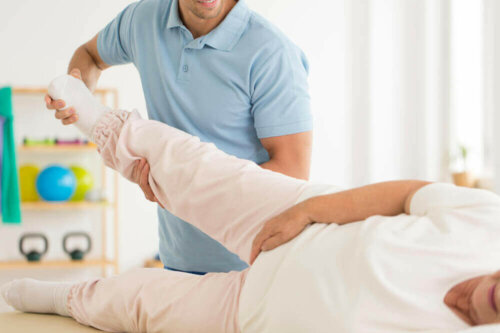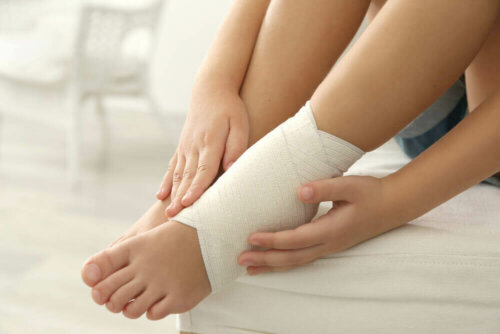How to Deal with a Dislocated Bone


Written and verified by the nurse Maria Marin Garcia
A dislocated bone is a distension of the ligaments and joint capsule (one of the ends of the bone), which makes the bone or joint come out of its place. Certain dislocations depend on several factors, such as physical condition, stability, elasticity, and strength of the muscles and tendons in charge of their movement.
Any joint could experience complete or incomplete dislocation. There’s complete dislocation if the bone comes out entirely and the natural articulation disappears. In turn, it’s an incomplete dislocation if it separates or dislocates without coming off entirely.
Overall, the most common dislocations happen in the fingers, shoulders, and hips.
What else would you like to know about it?
Continue reading to find out more about the causes and the course of action to take when confronted with this type of injury.
What causes a dislocation?
Bones are perfectly positioned and connected and form joints thanks to the support of numerous structures — ligaments, and muscles mainly. Unfortunately, there’s dislocation if a bone comes off the joint and doesn’t return to its normal position.
Any part of the body with dislodged joint structures becomes immobile and temporarily deformed, and causes pain. Dislocations are often due to sudden (unexpected) impacts on the joint.
They’re usually due to:
- Direct blows
- Joint twists in the wrong direction (such as twisting the ankle, for example)
- Falls

Risk factors
Some of the following further increase the likelihood of dislocations:
- In children, it may be because the cartilages that form part of the joint haven’t yet reached maturity and are still flexible
- At an advanced age, it increases the fragility of the bones, although generally, the cause would be due to bone fractures
- A hereditary factor, as some people are born with more flexibility than others
- A propensity for falls and other accidents
- Doing a physical activity, especially if it’s extraneous
You may be interested in Bone Contusion: Causes, Symptoms, and Treatments
What symptoms does a dislocated or dislocated bone cause?
Mainly, the exit of the articular structures can cause pinching of neighboring structures, such as nerves, blood vessels, ligaments, or adjacent muscles. All this makes the symptomatology similar in all cases of dislocation, such as:
- Tingling
- Numbness
- A sensation of intense pain
- Immobility of the joint (limitation of movement)
- Swelling
- The presence of hematomas (if any surrounding blood vessel is broken)
- The visible presence of the bone out of place
- A different color
- A deformity of the limb
Signs of an emergency:
- The bone protrudes through the skin
- There’s intense bleeding
- The affected area below the injury is pale, cold, and/or purple
What to do about a dislocated bone?
The bones can spontaneously return to their initial position but it doesn’t happen often. Hence, a person trying to help must perfectly know the proper repositioning technique to return it to its initial position. This is why it’ll be necessary to go to an ER as soon as possible and have a health professional take care of it.
Fortunately, the treatment can take place on an outpatient basis at the health center, and there may not be a need to visit a hospital in most cases. However, it’s important to know what to do until you get there so take the following into account:
- First, seek immediate medical assistance.
- Immobilize the joint and make no attempt to move the dislocated joint or force it back into place. This is because such movements could damage the joint and surrounding structures. The use of a sling may be helpful if one is available.
- Apply ice indirectly to help reduce swelling, reduce, bruising and fluid accumulation in the injured joint.
- Prevent shock by positioning yourself in a horizontal position and lift your feet at least one foot.

What not to do with a dislocated bone
As important as it is to know how to deal with a dislocated bone, it’s also necessary to know what are the contraindications, if any, before entering the ER, such as:
- Don’t move until the injury is completely immobilized.
- In addition, don’t move and don’t even try to get up if the injury happens in the hip.
- Never try to straighten a bone or a joint by applying force.
- Don’t try to find out if you can use the joint and wait for medical assistance.
- Finally, don’t take any medication without previous medical assistance.
Read about Bone Pain: Causes, Symptoms and Treatment
Treatment
The necessary treatment for simple dislocations is to reposition the joint through a traction maneuver done by a professional. It may be hard to believe, but the pain actually disappears immediately after this maneuver if there’s no damage to neighboring structures.
Surgery might be necessary for the reconstruction of the joint and other structures that may have been damaged in the case of bad dislocations.
All cited sources were thoroughly reviewed by our team to ensure their quality, reliability, currency, and validity. The bibliography of this article was considered reliable and of academic or scientific accuracy.
- Marx JA, et al. Rosen’s Emergency Medicine: Concepts and Clinical Practice. 8th ed. Philadelphia, Pa.: Mosby Elsevier; 2014. http://www.clinicalkey.com. Accessed Jan. 8, 2014.
- Lu Y, Xiao H, Xue F. Causes of and treatment options for dislocation following total hip arthroplasty. Exp Ther Med. 2019;18(3):1715–1722. doi:10.3892/etm.2019.7733
- Guía Primeros Auxilios – SSPRL . [cited 2020 Apr 23]. Available from: http://ssprl.gobex.es/ssprl/web/guest/guia-primeros-auxilios
- Roberts JR, et al. Roberts and Hedges’ Clinical Procedures in Emergency Medicine. 6th ed. Philadelphia, Pa.: Saunders Elsevier; 2014. http://www.clinicalkey.com. Accessed Jan. 8, 2015.
This text is provided for informational purposes only and does not replace consultation with a professional. If in doubt, consult your specialist.








